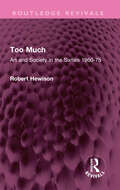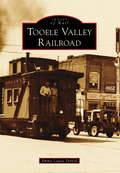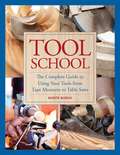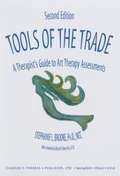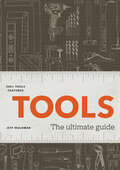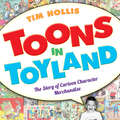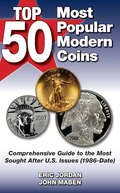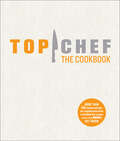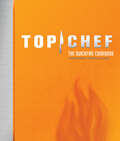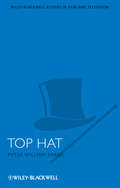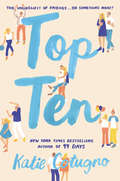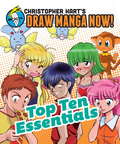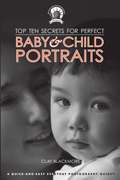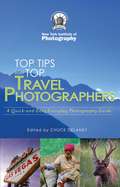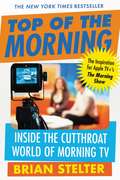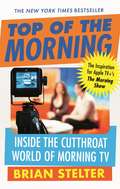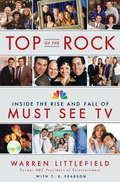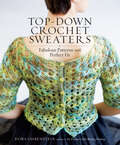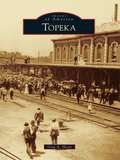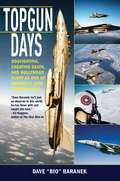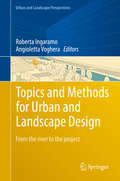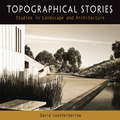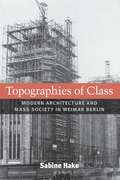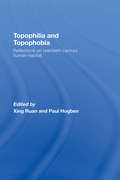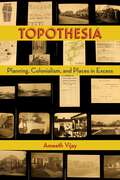- Table View
- List View
Too Much: Art and Society in the Sixties 1960-75 (Routledge Revivals)
by Robert HewisonFirst published in 1986, Too Much records the tumultuous period between 1960 and 1975 when, more than at any other time in history, the arts were a battleground for the conflicting forces of social change. With the new affluence of the Sixties the cultural conformism of the previous decade was rejected in favour of new forms of expression. Pop Art, pop music, fringe theatre and performance poetry helped to create the semi-mythological image of ‘Swinging London.’ The liberation ethic was feted as it masked the insecurities of a society in decline but, as a real political challenge to the status quo, it also led to conflict. The confrontation between official culture and the underground came in 1968, a year with its own mythical resonance. This book will be of interest to students of art, media studies and cultural studies.
Tooele Valley Railroad
by Emma Louise PenrodShortly after the International Smelter offered economic salvation to Tooele's struggling desert community, the Tooele Valley Railroad became the town artery. Though originally built in 1908 to connect the smelter to the Union Pacific and Western Pacific lines west of town, the railroad became central to daily life. Hundreds of local workers rode it to and from work each day. As technology continued to change Tooele, the Tooele Valley Railroad shared Vine Street with the first automobiles--safety precautions required that the caboose, with a horn mounted to warn motorists, lead the oncoming train. However, the smelter's decades of prosperity proved short-lived, and by the 1930s, the town had fallen on difficult times once again. The railroad outlived the smelter, but operations ceased in the early 1980s, and the city had the abandoned tracks removed.
Tool School: The Complete Guide to Using Your Tools from Tape Measures to Table Saws
by Monte BurchLearn the tools and the techniques with this invaluable resource for every woodworker.With any project, having the right tools is only half the battle. It's knowing how to use them that can make or break a project. Tool School is the all-in-one, easy-to-use reference for every woodworking tool there is, from hammers and nails to lathes, band saws, and portable electric sanders. With over forty years of experience, Burch guides the reader through the entire process of choosing, buying, and using the right tools to get the best results. Subjects covered include: Handsaws Chisels and gouges Hand planes Drills Routers Electric saws Radial arm and miter saws Boring tools Bench sands And many more!Fully illustrated with hundreds of color photographs and diagrams, Tool School is the essential manual for dozens of tools and an infinite number of projects. With this book, you will never buy the wrong tool again or work twice as hard to do half the work with a piece of equipment that isn't made for the job. Learn how to set up your tools accurately and safely to get the most out of your equipment every time you use it.
Tools of the Trade: A Therapist's Guide to Art Therapy Assessments (Second Edition)
by Stephanie L. BrookeThis new edition with its revised title provides critical reviews of art therapy tests along with some new reviews of assessments and updated research in the field. It is comprehensive in its approach to considering reliability and validity evidence provided by test authors. Additionally, it reviews research on art therapy assessments with a variety of patient populations. The book contains helpful suggestions regarding the application of art therapy assessments. Specific areas covered include individual, group, family, and multicultural assessment techniques. The desirable and undesirable features of a variety of art therapy assessments are deliberated. This book will be a valuable resource for practitioners who use art therapy as an adjunct or primary therapy, and it will serve to enhance clinical skills, making therapy more effective for each patient who participates in the assessment process. The book critiques a series of art therapy assessments-from traditional art therapy approaches to current releases. The goal of this work is to assist mental health professionals in selecting assessments that yield reliable and valid clinical information regarding their clients. Of special interest is the author's approach to writing the results of a series of art therapy assessments in an effort to provide a more complete indication of client dynamics and issues. It will be a valuable resource for practitioners who use art therapy as an adjunct or primary therapy, and it will serve to enhance clinical skills, making therapy more effective for each patient who participates in the assessment process.
Tools: The Ultimate Guide
by Jeff WaldmanA must-have compendium for anyone looking to learn about the fascinating world of over 500 essential tools.This is the book for answering all your tool questions, gaining knowledge before hiring a professional, or simply flipping through just for the joy of learning something new about the objects that shape our world.This expansive guide catalogs more than 500 tools for measuring, cutting, fastening, and shaping—from hammers and saws to wrenches, welders, and drawknives. Throughout these illustrated pages, you'll learn how to care for each tool so it can last a lifetime, as well as learn intriguing tidbits and fascinating histories of each object along the way.TONS OF INFORMATION: This chunky book is filled with detailed information about a wide variety of tools you'd find in a home improvement store; it will earn a spot in your garage, shed, workshop, or studio.EASY TO USE: Learn how to avoid wasting countless hours on head-scratching home repairs, wonky backyard builds, and failed garage tinkering.Perfect for:• New homeowners• Newly independent young adults seeking home literacy• Curious crafters, woodworkers, handymen/handywomen• Fans of THE ELEMENTS OF A HOME or HOW TO DO THINGS.
Toons in Toyland: The Story of Cartoon Character Merchandise
by Tim HollisEvery living American adult likely prized one childhood toy that featured the happy image of an animated cartoon or comic strip character. There is an ever-growing market for these collectibles, and stacks of books pose as pricing guides. Yet Tim Hollis is the first to examine the entire story of character licensing and merchandising from a historical view.Toons in Toyland focuses mainly on the post-World War II years, circa 1946-1980, when the last baby boomers were in high school. During those years, the mass merchandising of cartoon characters peaked. However, the concept of licensing cartoon characters for toys, trinkets, and other merchandise dates back to the very first newspaper comics character, the Yellow Kid, who debuted in 1896 and was soon appearing on a variety of items. Eventually, cartoon producers and comic strip artists counted on merchandising as a major part of their revenue stream. It still plays a tremendous role in the success of the Walt Disney Company and many others today.Chapters examine storybooks (such as Little Golden Books), comic books, records, board games, jigsaw puzzles, optical toys (including View-Master and Kenner's Give-a-Show Projector), and holiday paraphernalia. Extending even beyond toys, food companies licensed characters galore--remember the Peanuts characters plugging bread and Dolly Madison snacks? And roadside attractions, amusement parks, campgrounds, and restaurants--think Yogi Bear and Jellystone Park Campgrounds--all bought a bit of cartoon magic to lure the green waves of tourists' dollars.
Top 50 Most Popular Modern Coins
by Eric Jordan John MabenThe Best of TodayYou want to assemble a great coin collection, but your budget is limited. You're never going to be able to spend $10,000 or more for a gold coin from the 1800s. But that's okay. Today's modern U.S. coins offer collectors an opportunity to amass a collection of beautiful coins at an affordable price.Coins that were once considered a novelty of sorts, or just bullions for metals investors, have earned their place in numismatics. Today they represent a significant portion of all coins sold and are taken seriously by the market at large.Top 50 Most Popular Modern Coins shows you the "best of the best" in terms of popularity, scarcity and affordability. Using the 50 coins listed in this reference as a beginning, you can find your direction of choice in modern coins collecting by date, mintmark, or by composition. You may also choose the challenge of just collecting the 50 issues the authors have selected as the "best of the best."This book may well prove to be your most valuable tool in identifying and learning about the modern coins that are a must for all contemporary coin collectors.
Top Chef: The Cookbook
by Bravo MediaThe creators of Bravo’s Top Chef share inside stories and more than 100 recipes in this New York Times bestselling cookbook and series companion.In Top Chef: The Cookbook, Tom Colicchio invites fans and home chefs into the hottest kitchen on prime time. This volume features some of the most memorable winning recipes from the first three seasons, as well as dishes from the Elimination Rounds and the Quick-Fire Challenges. Here you’ll find Elia Aboumrad’s Breakfast, Lunch, and Dinner Waffles; C.J. Jacobson’s Crepes; Hung Huynh’s Tuna Tartare; Lea Anne Wong’s Deep Fried Oysters; Tre Wilcox III’s Bacon wrapped Shrimp; and much more.In-depth discussions with contestants, judges, and crew reveal the inner workings of the show, and lavish photographs take readers behind-the-scenes into the Top Chef pantry and competition sites. This cookbook will have aspiring culinary contenders reliving classic show moments and relishing new recipes!
Top Chef: The Quickfire Cookbook
by Bravo MediaThe creators of Bravo’s Top Chef share seventy-five Quickfire memorable recipes in this cookbook featuring tips, photos, contestant interviews, and more.The much-anticipated follow-up to the New York Times best-selling Top Chef: The Cookbook is here! Drawing from the first five seasons of the show, Top Chef: The Quickfire Cookbook features 75 of the best recipes—from Spike’s Pizza alla Greek to Stephanie’s Bittersweet Chocolate Cake—culled from the Top Chef Quickfire Challenges. Everything the home chef needs to assemble an impressive meal and channel the energy of the Quickfire kitchen is collected here, including advice on hosting a Quickfire Cocktail Party and staging your own Quickfire Challenges at home. Best of all, this book is spilling over with sidebar material, including tips for home chefs, interviews with contestants, fabulous photos, and fun trivia related to the chefs, dishes, and ingredients that make Top Chef a favorite.
Top Hat (Wiley-Blackwell Series in Film and Television #17)
by Peter William EvansTop Hat is the first volume to spotlight this classic Hollywood film, probing the musical genre, notions of romance and subjectivity, as well as the contested relations between the sexes. Offers a detailed analysis of one of Hollywood's greatest musicals, including a comprehensive survey of the film's production, promotion and reception, all measured against the background of 1930s socio-political contexts in the USA Explores the musical genre and questions of (gendered) national identity, romance, subjectivity and the notion of the couple Written in a clear, accessible style, Top Hat probes text and context carefully to appeal to the student and teacher of the musical and of Hollywood film history, as well as the film-loving general reader
Top Ten
by Katie CotugnoThe newest stunning and unforgettable contemporary realistic romance from the New York Times bestselling author of 99 Days, Fireworks, and How to Love. Perfect for fans of Sarah Dessen, Jenny Han, and Morgan Matson. Ryan McCullough and Gabby Hart are the unlikeliest of best friends. Prickly, anxious Gabby would rather do literally anything than go to a party. Ultra-popular Ryan is a hockey star who can get any girl he wants—and frequently does. But somehow their relationship just works; from dorky Monopoly nights to rowdy house parties to the top ten lists they make about everything under the sun.Now, on the night of high school graduation, everything is suddenly changing—in their lives, and in their relationship. As they try to figure out what they mean to each other and where to go from here, they make a final top ten list: this time, counting down the top ten moments of their friendship.
Top Ten Essentials: Christopher Hart's Draw Manga Now!
by Christopher HartTop Ten Essentials breaks down the 10 most common aspects that apply to any manga character, from a wild chibi to a bishoujo woman, into detailed lessons. Focusing on body proportion, different types of eyes, hair, poses, character types, expressions, and more, this book covers everything readers need to go from manga fans to manga artists. After an introduction to these elements, readers will have a chance to follow along Hart's in-depth step-by-steps, and will even be invited to draw on their own, right in the book's pages.
Top Ten Secrets for Perfect Baby & Child Portraits: Photography Tips For Every Parent And Grandparent From A Pro
by Clay BlackmoreToday's cash-conscious families can't afford to take professional portraits of their children each month. Top Ten Secrets for Perfect Baby & Child Portraits helps camera consumers get into the head of America's master baby, child, and portrait photographer--and his step-by-step guidance will help anyone take better photographs. Clay Blackmore, a professional photographer and proud father of a young son, shows anyone how to shoot the top baby and child photos with any compact point-and-shoot or DSLR camera. Now parents can take professional-quality photos, preserving precious memories and milestones. Blackmore provides insight, background, tips, and guidelines for his ten favorite types of baby and child photographs, all based on lighting situations ranging from window light to setting up a makeshift home studio with one or more lighting sources. Color photographs from his professional and personal portfolio illustrate each step and provide inspiration. Book Bonus: an exclusive password to a 20-minute online instructional how-to video with the author demonstrating each cluster of photo techniques.
Top Travel Photo Tips: From Ten Pro Photographers
by Chuck Delaney New York Institute of PhotographyMore families are taking vacations and trips than ever before--over 81 percent of Americans plan to travel for two or more weeks in the coming year. Top Tips from Top Travel Photographers interviews ten prominent and diverse professional travel photographers to get their top tips, techniques, and trade secrets. Chase Guttman, Peter Guttman, Michael Doven, Chris Corradino, and other experts sit down with New York Institute of Photography director Chuck DeLaney. They openly share favorite photographs and advice to help hobbyist and amateur photographers come back from their outings and trips with excellent photographic art for their walls, websites, blogs, and family albums. Book Bonus: an exclusive password to instructional how-to videos from some of the book's experts.
Top of the Morning: Inside the Cutthroat World of Morning TV
by Brian StelterLike Bill Carter chronicling the late night wars in his classic The Late Shift, star New York Times reporter Brian Stelter reveals all the dish and dirt behind the polite smiles and perky demeanors of morning television in his much-anticipated...TOP OF THE MORNINGWhen America wakes up with personable and charming hosts like Matt Lauer, Robin Roberts, and George Stephanopoulos, it's hard to imagine their show bookers having to guard a guest's hotel room all night to prevent rival shows from poaching. But that is just part of the intense reality New York Times staff writer Brian Stelter reveals in TOP OF THE MORNING--a gripping look at the most competitive time slot in television, complete with Machiavellian booking wars and manic behavior by the producers, executives, and stars.Stelter is behind the scenes as Ann Curry replaces Meredith Vieira on the Today show, only to be fired a year later in a fiasco that made national headlines. He's backstage as Good Morning America launches an attack to dethrone Today and end the longest consecutive winning streak in morning television history. And he's there as Roberts is diagnosed with a crippling disease-on what should be the happiest day of her career.Featuring exclusive material about current and past morning stars like Katie Couric and all the major players of the 2000s, TOP OF THE MORNING illuminates what it takes to win the AM, when every single viewer counts, tons of jobs are on the line, and hundreds of millions of dollars are at stake. Among the questions Stelter answers for the first time: Why did NBC really decide to oust Curry from her chair? What was her replacement Savannah Guthrie's reaction? Was Matt Lauer really at fault?So grab a cup of coffee, sit back, and discover the dark side of the sun.
Top of the Morning: The Inspiration for Apple TV's THE MORNING SHOW
by Brian StelterDiscover the cutthroat world behind the polite smiles and perky demeanors of morning news in the book that inspired the Apple TV series starring Reese Witherspoon, Jennifer Aniston, and Steve Carrell.When America wakes up with personable and charming TV hosts, it's hard to imagine their show bookers having to guard a guest's hotel room all night to prevent rival shows from poaching. But that is just a glimpse of the intense reality revealed in this gripping look into the most competitive time slot in television.Featuring exclusive content about all the major players in American morning television, the book illuminates what it takes to win the AM -- when every single viewer counts, tons of jobs are on the line, and hundreds of millions of dollars are at stake. Author Brian Stelter is behind the scenes as Ann Curry replaces Meredith Vieira on the Today show, only to be fired a year later in a fiasco that made national headlines. He's backstage as Good Morning America launches an attack to dethrone Today and end the longest consecutive winning streak in morning television history. And he's there as Roberts is diagnosed with a crippling disease -- on what should be the happiest day of her career.So grab a cup of coffee, sit back, and discover the dark side of the sun.PRAISE FOR TOP OF THE MORNING"Mr. Stelter pulls back the curtains and exposes a savage corporate world that might have been inhabited by the Sopranos." - Washington Times"A troubling look inside an enterprise as vicious and internecine as a soap opera." - Kirkus Reviews
Top of the Rock
by Warren LittlefieldSeinfeld, Friends, Frasier, ER, Cheers, Law & Order, Will & Grace...Here is the funny, splashy, irresistible insiders' account of the greatest era in television history -- told by the actors, writers, directors, producers, and the network executives who made it happen...and watched it all fall apart.Warren Littlefield was the NBC President of Entertainment who oversaw the Peacock Network's rise from also-ran to a division that generated a billion dollars in profits. In this fast-paced and exceptionally entertaining oral history, Littlefield and NBC luminaries including Jerry Seinfeld, Jason Alexander, Kelsey Grammer, Matt LeBlanc, Lisa Kudrow, Julianna Marguiles, Anthony Edwards, Noah Wylie, Debra Messing, Jack Welch, Jimmy Burrows, Helen Hunt, and Dick Wolf vividly recapture the incredible era of Must See TV. From 1993 through 1998, NBC exploded every conventional notion of what a broadcast network could accomplish with the greatest prime-time line-up in television history. On Thursday nights, a cavalcade of groundbreaking comedies and dramas streamed into homes, attracting a staggering 75 million viewers and generating more revenue than all other six nights of programming combined. The road to success, however, was a rocky one. How do you turn a show like Seinfeld, one of the lowest testing pilots of all time, into a hit when the network overlords are constantly warring, or worse, drowning in a bottle of vodka? Top of the Rock is an addictively readable account of the risky business decisions, creative passion, and leaps of faith that made Must See TV possible. Chock full of delicious behind-the-scenes anecdotes that run the gamut from hilarious casting and programming ploys to petty jealousies and drug interventions, you're in for a juicy, unputdownable read.
Top-Down Crochet Sweaters: Fabulous Patterns with Perfect Fit
by Dora OhrensteinWelcome to the new era of crochet. Making garments from the top down is a favorite knitting technique that allows knitters to test and adjust the fit as they go. Now, thanks to designer Dora Ohrenstein, crocheters will benefit for the first time from a pattern book featuring the same beloved approach. These 14 fashionable patterns are sure to flatter bodies of all shapes and sizes. Show-stopping original photography, an extensive discussion of the benefits of top-down construction, and detailed instructions on how and why to adjust the patterns to ensure an exquisite customized fit will have crocheters tying themselves in knots to start strutting their stuff!
Topeka
by Greg A. HootsThe city of Topeka was founded on December 5, 1854, by nine men who made camp by the Kansas River at what is today the intersection of First and Kansas Avenues. During Kansas's territorial days, Topeka played a leading role in the Free State movement. In 1858, Topeka was voted the Shawnee County seat, and in 1859 secured the position of state capital at the final constitutional convention, which took effect when Kansas achieved statehood in 1861. In the century and a half that followed, Topeka grew as America grew, developing a rich history. Now home to 125,000 citizens, Topeka has become one of the leading metropolitan cities in the Midwest. Images of America: Topeka celebrates the city's history in photographs, drawing on the vast photographic collection of the Kansas State Historical Society as well as other private and public collections.
Topgun Days: Dogfighting, Cheating Death, and Hollywood Glory as One of America's Best Fighter Jocks
by Dave BaranekDave Baranek (callsign "Bio") was one of 451 young men to receive his Wings of Gold in 1980 as a naval flight officer. Four years later, seasoned by intense training and deployments in the tense confrontations of the cold war, he became the only one of that initial group to rise to become an instructor at the navy's elite Fighter Weapons School. As a Topgun instructor, Bio was responsible for teaching the best fighter pilots of the Navy and Marine Corps how to be even better. He schooled them in the classroom and then went head-to-head with them in the skies.Then, in August 1985, Bio was assigned to combine his day-to-day flight duties with participation in a Pentagon-blessed project to film action footage for a major Hollywood movie focusing on the lives, loves, heartbreaks, and triumphs of young fighter pilots: Top Gun.Bio soon found himself riding in limousines to attend gala premieres, and being singled out by giggling teenagers and awed schoolboys who recognized the name "Topgun" on his T-shirts. The book ends with his reflections on his career as a skilled naval aviator and his enduring love of flight. The paperback and Kindle editions include more than fifty rare full color photographs of fighter jets in action.
Topics and Methods for Urban and Landscape Design
by Roberta Ingaramo Angioletta VogheraThis book combines urban planning and architectural tools in an attempt to overcome the limitations of sectoral measures. In this perspective, it offers a forum for the debate of different approaches used by schools of planning and architecture. It explores strategies by drawing from the potential contributions of cognitive models for decisions, the role of utopian thinking and retrofitting actions and their interconnectedness, the role of cultural legacy for urban and landscape design, the design perspectives about public spaces, and the role of architecture design and urban and regional planning for landscape quality. The book also discusses on design as a process of decision-making that operates as an act of empathy that aligns with human and ecological values - emotional, physical and socio-cultural. Each planning and design act has different possible effects able to help making clear strategic and local actions, contributing to community empowerment and to landscape and local governance. Design activity along the river and multiple experiences (design processes, urban fringe design, agri-urban models, river parks, UNESCO sites, River Contracts, greenbelts and ecological networks), through reflection on design roles, helping to understand the design process and its results at different scales. Roberta Ingaramo, architect, PhD, is Assistant Professor in Architectural and Urban Design, Department of Architecture and Design (DAD), Polytechnic University of Turin (Italy), Master in Conservation of Historic Towns and Buildings, Katholieke Universiteit (Belgium). roberta. ingaramo@polito. it Angioletta Voghera, architect, PhD, is Associate Professor of Urban and Regional Planning, Inter-university Department of Urban and Regional Studies and Planning (DIST), Polytechnic University of Turin (Italy). angioletta. voghera@polito. it
Topographical Stories
by David LeatherbarrowLandscape architecture and architecture are two fields that exist in close proximity to one another. Some have argued that the two are, in fact, one field. Others maintain that the disciplines are distinct. These designations are a subject of continual debate by theorists and practitioners alike.Here, David Leatherbarrow offers an entirely new way of thinking of architecture and landscape architecture. Moving beyond partisan arguments, he shows how the two disciplines rely upon one another to form a single framework of cultural meaning. Leatherbarrow redefines landscape architecture and architecture as topographical arts, the shared task of which is to accommodate and express the patterns of our lives. Topography, in his view, incorporates terrain, built and unbuilt, but also traces of practical affairs, by means of which culture preserves and renews its typical situations and institutions.This rigorous argument is supported by nearly 100 illustrations, as well as examples of topography from the sixteenth, eighteenth, and nineteenth centuries, through the heroic period of early modernism, to more recent offerings. A number of these studies revise existing accounts of decisive moments in the history of these disciplines, particularly the birth of the informal garden, the emergence of continuous space in the landscapes and architecture of the modern period, and the new significance of landform or earthwork in contemporary architecture. For readers not directly involved with either of these professions, this book shows how over the centuries our lives have been shaped and enriched by landscape and architecture.Topographical Stories provides a new paradigm for theorizing and practicing landscape and architecture.
Topographies of Class: Modern Architecture and Mass Society in Weimar Berlin
by Sabine HakeIn Topographies of Class, Sabine Hake explores why Weimar Berlin has had such a powerful hold on the urban imagination. Approaching Weimar architectural culture from the perspective of mass discourse and class analysis, Hake examines the way in which architectural projects; debates; and representations in literature, photography, and film played a key role in establishing the terms under which contemporaries made sense of the rise of white-collar society. Focusing on the so-called stabilization period, Topographies of Class maps out complex relationships between modern architecture and mass society, from Martin Wagner's planning initiatives and Erich Mendelsohn's functionalist buildings, to the most famous Berlin texts of the period, Alfred Döblin's city novelBerlin Alexanderplatz(1929) and Walter Ruttmann's city filmBerlin, Symphony of the Big City(1927). Hake draws on critical, philosophical, literary, photographic, and filmic texts to reconstruct the urban imagination at a key point in the history of German modernity, making this the first study---in English or German---to take an interdisciplinary approach to the rich architectural culture of Weimar Berlin. Sabine Hake is Professor and Texas Chair of German Literature and Culture at the University of Texas at Austin. She is the author of numerous books, includingGerman National CinemaandPopular Cinema of the Third Reich. Cover art: Construction of the Karstadt Department Store at Hermannplatz, Berlin-Neukölln. Courtesy Bildarchiv Preeussischer Kulturbesitz / Art Resource, NY
Topophilia and Topophobia: Reflections on Twentieth-Century Human Habitat
by Xing RuanThis book is about the love and hate relations that humans establish with their habitat, which have been coined by discerning modern thinkers as topophilia and topophobia. Whilst such affiliations with the topos, our manmade as well as natural habitat, have been traced back to antiquity, a wide range of twentieth-century cases are studied here and reflected upon by dwelling on this framework. The book provides a timely reminder that the qualitative aspects of the topos, sensual as well as intellectual, should not be disregarded in the face of rapid technological development and the mass of building that has occurred since the turn of the millennium.Topophilia and Topophobia offers speculative and historical reflections on the human habitat of the century that has just passed, authored by some of the world’s leading scholars and architects, including Joseph Rykwert, Yi-Fu Tuan, Vittorio Gregotti and Jean-Louis Cohen. Human habitats, ranging broadly from the cities of the twentieth century, highbrow modern architecture both in Western countries and in Asia, to non-architect/planner designed vernacular settlements and landscapes are reviewed under the themes of topophilia and topophobia across the disciplines of architecture, landscape studies, philosophy, human geography and urban planning.
Topothesia: Planning, Colonialism, and Places in Excess
by Ameeth VijaySHORTLISTED, 2024 MSA FIRST BOOK PRIZETopothesia reads urban planning as a mode of speculative fiction, one inextricably linked to histories of British colonialism and liberalism through a particular understanding of place. The book focuses on town planning from the late nineteenth century to the present day, showing how the contemporary geography of Britain—sharply unequal and marked by racial division—continues ideologies of place established in colonial contexts. Specifically, planning allows for the speculative construction of future places that are both utopian in their ability to resolve political disagreement and at the same tantalizingly realizable, able to be produced in concrete reality. This speculative imaginary, I argue, is only possible within the ideological framework of colonialism and the history of empire within which it developed. Topothesia refers to a rhetorical device employing the vivid depiction of an often-imaginary place. This device, Vijay shows, helps us understand urban planning as a narrative genre, one that, even in its most mundane documents, is compelled to produce elaborate fantasies of future places. The book examines specific planning movements over time to understand the form and the stakes of their speculative worlds. In building these worlds, the book shows, planners continually coopted literary critiques of the present and reveries of the future, retaining literature's aesthetics while eschewing its politics. At the same time, Vijay shows, writers and artists have dwelled within and against these colonial imaginaries to seek other means of representing place.
